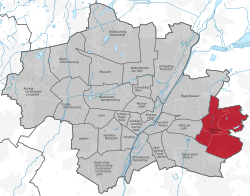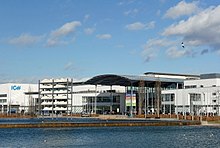
Munich is the capital and most populous city of the Free State of Bavaria, Germany. With a population of 1,589,706 inhabitants as of 29 February 2024, it is the third-largest city in Germany, after Berlin and Hamburg, and thus the largest which does not constitute its own state, as well as the 11th-largest city in the European Union. The city's metropolitan region is home to about 6.2 million people and the third largest metropolitan region by GDP in the European Union.

Gröbenzell is a municipality and suburb to Munich in the district Fürstenfeldbruck, in Bavaria, Germany. It was founded in 1952, and has a population of 19,202. Gröbenzell is often called a garden city, which is also illustrated by the two flowers in the coat of arms.

On 17 December 1960, a Convair C-131D Samaritan operated by the United States Air Force on a flight from Munich to RAF Northolt crashed shortly after take-off from Munich-Riem Airport, due to fuel contamination. All 20 passengers and crew on board as well as 32 people on the ground were killed.

Trudering is one of two quarters forming the Trudering-Riem borough of Munich, the other one being Riem. It is primarily residential, offering access to U-Bahn and S-Bahn services at the München Trudering railway station. The main traffic artery B304 connects the quarter with the city centre and Wasserburg am Inn.

Munich-Trudering station is an interchange station of the Munich S-Bahn and the Munich U-Bahn in the borough of Trudering-Riem in the Bavarian capital of Munich.

Munich-Riem Airport was an international airport of Munich, the capital city of Bavaria and third-largest city of Germany. It was closed down on 16 May 1992, the day before the new Munich Airport commenced operations. It was located near the old village of Riem in the borough of Trudering-Riem in the east of Munich.

Aubing-Lochhausen-Langwied is the 22nd borough of the German city of Munich. The districts Aubing, Lochhausen and Langwied were incorporated together in 1942, thus forming the largest borough of the city at 3,400 hectares, yet having the lowest density of population with 37,352 residents as of 2002. This large borough still accommodates many vast agricultural and forest areas that together with the Aubinger Lohe and the Langwieder lake district, fulfill the balance of nature in the area and offer recreational facilities to all of western Munich.

Messestadt Riem is an urban district in the east of Munich. It is part of the municipality 15 Trudering-Riem, and located entirely on the grounds of Munich-Riem airport which closed in 1992 and now comprises a residential area, the Neue Messe München trade fair center and the Riem Arcaden shopping mall.

Haidhausen is a quarter of Munich, Germany. It is now part of the borough—or stadtbezirk—number 5 Au-Haidhausen.

Neuhausen-Nymphenburg is a borough of Munich, the capital of the German state of Bavaria. It was created from the merger of the former boroughs of Neuhausen and Nymphenburg in 1992.

Maxvorstadt is a central borough of Munich, Bavaria, Germany and forms the Stadtbezirk (borough) 3 Maxvorstadt. Since 1992, this borough comprises the former boroughs 5, 6 and 7.
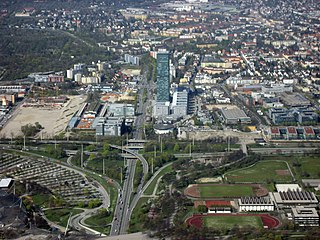
Moosach is the 10th northwestern district of Munich, Bavaria, Germany. It is sectioned in the urban districts Hartmannshofen, Pressestadt and Borstei.

Munich-Riem station is an S-Bahn station and container terminal in the east of Munich in the district of Trudering-Riem on the Munich–Mühldorf railway in the German state of Bavaria. The station is served by the Munich S-Bahn and is classified by Deutsche Bahn as a category 4 station.

Ramersdorf-Perlach is a borough of Munich. It is located south-east of the city center and is the most populous of Munich's boroughs with a population of about 116,000. It consists of the five districts Ramersdorf, Balanstraße West, Altperlach, Neuperlach and Waldperlach.

The Stammstrecke 2 of the Munich U-Bahn is one of three main routes in the subway network of the Bavarian capital Munich. It runs from north to south, as well as east, and is currently operated by the underground U1 and U2 lines. Since 12 December 2011, the U7 line runs during high traffic times and since 15 December 2013 the U8 line assists on Saturdays. The U1 and U2 lines only run together on one route, in the central inner city area, before and after that, they are branched away from each other. The main line 2 has a total length of 33.8 kilometers and 38 underground stations. It runs exclusively in the city of Munich and completely in the tunnel.
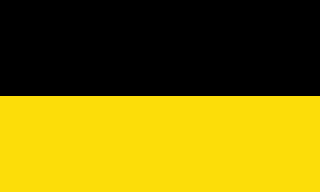
The following outline is provided as an overview of and topical guide to Munich:

The Munich Fire Department is the firefighting authority of the City of Munich. The Munich fire department is divided into a professional department with approximately 1500 fire fighters staffing a total of 10 fire stations located strategically throughout the city to meet the legal aid period of 10 Minutes, and a volunteer fire department, whose approximately 1,050 members are organized in 22 companies. Each year, the Munich Fire Department responds to about 80,000 calls. The volunteers respond to about 3,500 calls annually. This makes the Munich Fire Department the third largest fire department as well as the largest municipal fire department in Germany.

Neuhauser Straße is part of the first and largest pedestrian zone in Munich's Old Town. Here, many retail shops and restaurants are to be found.
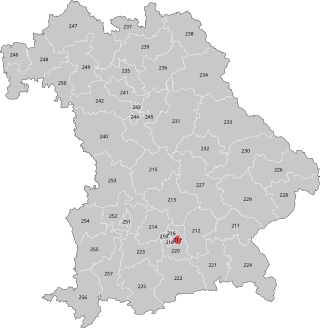
Munich East is an electoral constituency represented in the Bundestag. It elects one member via first-past-the-post voting. Under the current constituency numbering system, it is designated as constituency 217. It is located in southern Bavaria, comprising the eastern part of the city of Munich.

